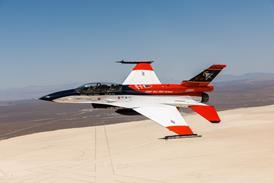THE FINAL standard model of the three-stage, air-launched Pegasus booster carried the US Air Force's Miniature Sensor Technology Integration satellite, MSTI 3, into orbit on 17 May. It was the sixth successful launch of the Orbital Sciences (OSC) booster since April 1990.
The Pegasus was released from an OSC Lockheed L-1011 at 38,000ft (11,600m) over the Pacific Ocean. The MSTI entered an initial 361 x 296km, 97°-inclination orbit, eventually reaching a circular 425km orbit.
A stretched Pegasus XL, which had its first successful flight on 8 March after two successive failures, has been manifested to launch 14 satellites, including five for NASA, starting with the Total Ozone Mapping Spectrometer in June.
Four further launches are in the pipeline for this year: the Fast Auroral Snapshot Explorer (due in August), Spain's Minisat (September), the Satelite de Aplicaciones Cientificas (SAC-B), from Argentina, together with NASA's High Energy Transient Experiment (November), and the Submillimeter Wave Astronomy Satellite (December).
Source: Flight International
















